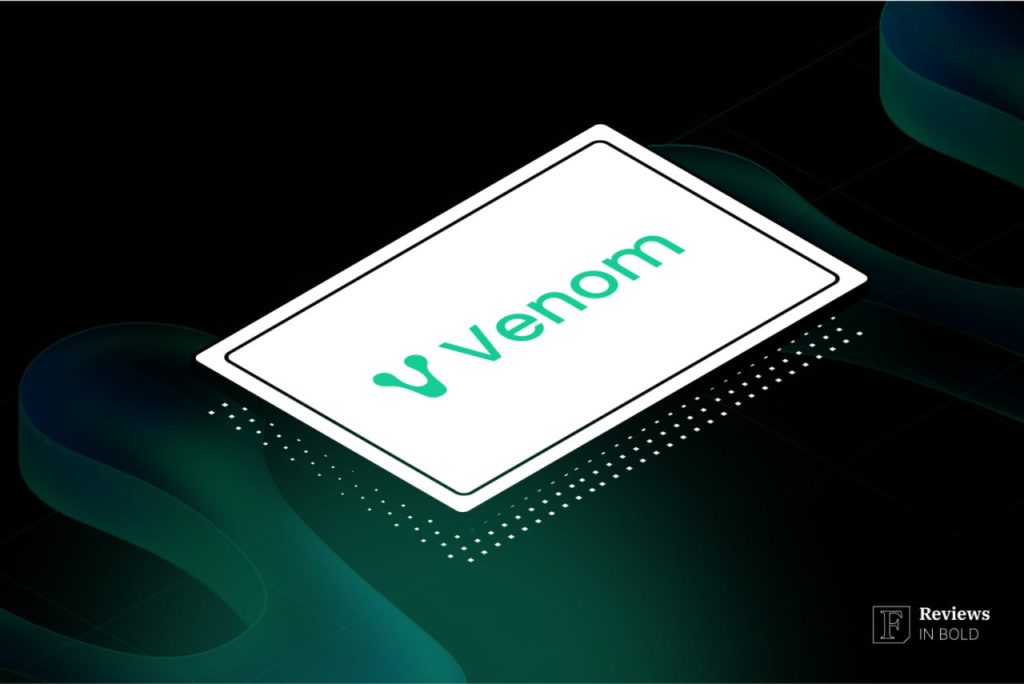This review will look at the Venom Network, a highly scalable, transparent, and secure Layer-0 blockchain protocol designed to host web3 applications. Specifically, we will consider its architecture, core features, competitive advantage, and products that comprise its ecosystem. Additionally, you are going to find a simple-to-follow tutorial on how to get started using Venom.
About Venom
Being ‘Turing-complete’ means Venom can host self-executing programming scripts (called smart contracts) similar to Ethereum (ETH). As a result, this enables Venom to run and host Web3 applications in various verticals, including decentralized finance (DeFi), decentralized autonomous organizations (DAO), and Game Finance (GameFi) spaces, among others.
Venom declares, that its mission is to be the infrastructure for the next generation of digital services and products.

As the popularity of blockchain technology grows, the challenges that most protocols are facing become evident, such as:
- Scaling in real-time – most blockchain solutions are not able to handle increasing workloads which limit their usage, and this is a significant drawback for most leading blockchains, including Bitcoin (BTC);
- Security and stability – blockchain protocols are designed to facilitate value transfer. It is essential for protocol developers to ensure that they secure their systems and attract enough genuine transaction validators and incentivize appropriate behavior to safeguard the sanctity of the decentralized networks;
- Cost structure – decentralized networks must be cheap enough to attract users while ensuring they offer sustainable services.
However, Venom declares that it solves these challenges using an innovative heterogeneous blockchain (one with multiple layers and components all working asynchronously) architecture involving dynamic sharding to create a multi-blockchain platform ideal for business and retail users. The blockchain is designed to be highly scalable, decentralized, and cost-effective.
The Venom Architecture
The Venom Foundation employs a heterogeneous multi-blockchain architectural approach to its blockchain design to solve the scalability challenge while reducing transaction fees. Notably, three layers comprise the Venom blockchain:
- Masterchain;
- Workchains;
- Shardchains.
The three layers support parallel transaction processing, which is why Venom can process as many as 100,000 to 1M transactions every second (TPS).

1. Masterchain
The Masterchain is also called the base layer, or Layer-0, as it is the backbone of the Venom blockchain. The primary function of this layer is to:
- Provide high-level security for the Workchains;
- Store network configuration settings;
- Hold information on validators, their stakes, and election rounds;
- Store block proof data from all Workchains.
As a Layer-0 blockchain, Venom can support other blockchains, which can be launched on top of the current infrastructure and either run independent protocols with its own native currency and virtual machine or inherit the features of Layer-0.
At launch, Venom was released with two chains, the Masterchain, and the Basechain. The latter is a Layer-1 Workchain to be used by end-users. This layer can be used to host decentralized apps (dApps).
The Venom blockchain supports a unique virtual machine dubbed the Threaded Virtual Machine (TVM) that enables it to support the deployment of smart contracts similar to Ethereum’s Virtual Machine (EVM). The same is also true of the Basechain on which dApps are currently being deployed.
Note
2. Workchains
Workchains are specialized Layer-1 blockchains that can be used to achieve or serve various purposes. This open-ended nature of Workchains means that they are capable of supporting a wide array of applications, from finance-based DeFi applications to Gaming and the Metaverse ecosystem blockchains.
It is also ideal to have these various applications segregated because various industries require varying degrees of security, compliance, and privacy levels. Therefore, even though the Workchains are hosted on the same Layer-0 blockchain, they still have the flexibility to adhere to varying vertical-specific constraints.
It’s with noting that the Venom Masterchain is able to support as many as 2^32 Workchains.
3. Shardchains
Shards are constituent pieces or partitions of a blockchain that hold information on a subset of the accounts running on the main chain. Sharding has been discovered to be a scalability solution for decentralized networks enabling parallel transaction processing as each shard has its own validator sets simultaneously working on a pool of transactions.
With Venom, there is initially a single shardchain that is responsible for processing all transactions. However, if and when it experiences a higher-than-average workload, there will be an automatic shard split, and the transactions will be subdivided amongst the two new shardchains.

This process repeats until the workload is split amongst an appropriate amount of shard chains which are then able to process the available transactions fast and cost-effectively comfortably.
There is, however, a limit to the number of shard chains each Workchain can support, and that is 2^60 shard chains.
Key Features of Venom Blockchain
There are three core features that are portrayed by the Venom blockchain, and these are:
- Dynamic sharding;
- Hybrid consensus mechanism;
- Asynchronous Architecture.
Let’s delve deeper into each of these features.
1. Dynamic sharding
We have already mentioned this feature in the previous section, but it is worth reiterating as it is an important feature for the Venom blockchain. Dynamic sharding is a way for the blockchain to increase the number of shards or shard chains used to process transactions in parallel.
It initially starts with a single shard, but the number will increase or reduce according to network demand to a maximum of 2^60 shards. It is this feature that is largely responsible for the 100K TPS figure.
2. Consensus Mechanism
Venom employs a hybrid consensus mechanism approach that includes both Proof of Stake (PoS) and Byzantine fault tolerance (BFT) algorithms. With PoS, transaction validators are required to stake a portion of their assets, which then enables them to participate. The higher the stake, the higher the probability that the validator will create a follow-up block.
The BFT algorithm ensures that the validators agree on the true version of the Venom blockchain following a round of voting. For this to happen, at least two-thirds of the validators need to agree.
Using both PoS and BFT consensus algorithms also adds to the speed of transaction validation and contributes to fast network verification.
3. Asynchronous Architecture
Being asynchronous means that a system made up of various components allows for uncoordinated communication. In the case of the Venom blockchain, the three core components – Masterchain, Workchains, and Shardchains can operate independently of one another. Most importantly, they do operate simultaneously.
This means that transactions are processed faster, more cheaply, and more efficiently. Additionally, asynchronous architecture is ideal when it comes to supporting Workchains in different verticals with varying blockchain needs.
The Venom Ecosystem
The Venom ecosystem is a suite of tools and services designed to enhance users’ experiences as they navigate and take advantage of the available Venom features.

The ecosystem includes the following services:
- The Venom wallet – this is a non-custodial cryptocurrency wallet for storing digital assets native to the Venom blockchain, such as the VENOM token, NFTs, and other custom tokens. Other functionalities include sending and receiving tokens, accessing Web3 marketplaces, swapping between multiple tokens, etc.;
- Venom Bridge – a bridge is a dApp that facilitates the exchange of digital tokens from one blockchain to another. The Venom bridge supports such swaps between Venom, Fantom (FTM), BNB Chain (BSC), and Ethereum networks;
- Venom Pools – validators who wish to verify transactions on Venom will utilize the Pools feature to stake their VENOM tokens, redeem rewards and participate in other governance activities. This feature is currently in testnet mode;
- Web3World – this is a decentralized exchange (DEX) based on the Venom blockchain that relies on the automated market maker (AMM) model to source for liquidity and offers the widest range of swap pairs with the deepest liquidity possible. Similarly, as of publication, this DEX is yet to launch officially;
- Venom Scanner – as the name suggests, a scanner is an explorer service that enables users to track transactions, fee trends, and other vital network-related metrics;
- Oasis Gallery – this is the first NFT marketplace on Venom to support non-fungible tokens created natively on Venom. Users can browse, buy, sell, and trade these digital assets here when it launches.
These are only the official dApps created and maintained by Venom Foundation. The community is also able to create and launch custom applications cost-effectively, meaning that with increasing adoption, there is bound to be a growing number of dApps on Venom.
Venom Blockchain’s Competitive Advantage
Blockchains often suffer from a slew of the following challenges, some of which are easy to fix while others are impossible. The challenges include:
- Scaling in real-time;
- Reliable and stable service;
- Limited transaction throughput;
- High transaction fees or network fees;
- Blockchain trilemma (choosing between scalability, security, and decentralization)
Here are the five ways that Venom has opted to tackle these and other issues that befall its rivals;
- Scalability – Venom has adopted the asynchronous blockchain architecture that integrates dynamic sharding and horizontal scaling to process more than 100K transactions every second and a ceiling of 1M;
- Regulation – the biggest challenge most blockchains have when it comes to global adoption is figuring out how to comply with laws and regulations. Even Bitcoin has been dogged by this challenge. This is not the case for the Venom Foundation, which has managed to achieve a first by getting an operating license from the Abu Dhabi Global Market;
- Interoperability – most blockchains exist in a silo of their making, implementing protocols that are not compatible with other market players. With Venom, the Foundation is looking into cross-chain integrations with leading blockchains such as Ethereum and enabling easy porting of EVM-based dApps. Currently, users can still use their ERC-20 tokens on Venom by bridging them using the Venom Bridge;
- Security – Venom has opted to employ a hybrid approach to transaction verification and general blockchain security. The network uses staking through PoS and the Byzantine fault-tolerant consensus algorithms. A crucial benefit of using staking is that compared to mining, it more likely encourages the decentralization of a blockchain by making it easier for small players to participate in governance and transaction verification;
- Adoption – Venom does not limit itself to only appeal to either retail or institutional users. Its design is able to accommodate every kind of user, including governments, corporates, non-governmental organizations, and individuals.
Tokenomics: Venom Token [VENOM]
The Venom blockchain has a native platform cryptocurrency dubbed the VENOM token, which is instrumental in value transfer within the Venom ecosystem.
The VENOM token is currently inflationary, with an initial market supply of 7.2 billion tokens. Documentation shows that there are plans by the Foundation to alter supply metrics and shift to a deflationary model in the future once certain key indicators are achieved, including adoption, volume, and utility.
Token Utility
VENOM serves four primary purposes:
- Payment of transaction fees;
- Governance through the PoS consensus mechanism;
- Incentivizing validators to participate in the transaction verification process for rewards;
- Enhancing network security through the attraction of enough validators.
How to get started using Venom Blockchain
This process only applies to individuals who want to join the Venom community and take advantage of the various tools and services offered to the public. It entails creating a new crypto wallet to store VENOM tokens, among other assets.
Step 1 – Download & Install Venom Wallet.
To begin, visit the Venom Foundation website, scroll down, and locate the download panel as shown below.

There are two main options: download the app or install the browser extension for Chrome. We have opted for the latter in this tutorial, but the process is similar even on the application interface.
On the Chrome extensions webpage, click on the [Add to Chrome] button in the top right corner. If you are using the Brave Browser, as in this example, you will instead see the [Add to Brave] button.

Once you click the button, the extension will install in the background and automatically redirect you to the wallet creation page.
Step 2 – Create your wallet.
Select the [Create a new wallet] option.

Next, accept the website’s privacy policy, then hit the [Submit] button.

The next screen shows you a list of words. These are your backup phrases. Ensure that you write them onto a piece of paper and keep them in a safe place.

Once you do, hit the [I wrote it down on paper] button to continue to the verification step. Here, the system will prompt you to provide a random word from the phrase to ascertain that you did write it down.

Click [Confirm] to continue.
Step 3 – Set a password.
Before you log into your Venom wallet, you must create a password and confirm it.

Click the [Create the Wallet] button to finish the process.

Congratulations, you now have a Venom wallet and a public wallet address you can use to interact and transact within the Venom ecosystem.
Is the Venom Blockchain Safe?
The Venom Foundation claims that it has taken several steps to ensure that its blockchain is as secure as possible. Here are some of these measures:
- Self-custody of assets – the Venom blockchain allows users to hold assets in a self-custody wallet which increases their safety as opposed to offering custody services as most cryptocurrency exchanges do;
- Regulations – the Venom Foundation has opted to obtain an operating license from the Abu Dhabi Global Market, thereby which shows that the organization is willing to operate within laws and regulations designed to protect the public;
- Hybrid consensus mechanism – Venom blockchain employs both PoS staking and BFT consensus algorithms designed to increase security without sacrificing scalability. With PoS, validators will have to stake a portion of their assets which acts as an incentive for good behavior.
Venom Blockchain Pros and Cons

Pros
- Venom Foundation is regulated by the Abu Dhabi Global Market;
- It’s highly scalable, supporting 100K to 1M transactions per second;
- The Threaded Virtual Machine uses Solidity programming language, the most common smart contract development language;
- Cross-chain interoperability through the support of multiple coins and tokens supported on rival blockchains, including Ethereum, BNB Smart Chain, and Fantom;
- Minimal transaction costs as low as $0.0002 per transaction;
- Fast transaction confirmation times of between 0.2 and 0.3 seconds.
- Blockchain is globally accessible for users, validators, and community members.

Cons
- Not EVM compatible at the moment;
- Being a newly launched blockchain, Venom has a little-to-no history;
- Centralization fears due to control by the Venom Foundation, which is also regulated.
Community Support Channels
- Website: https://venom.foundation/
- Twitter: https://twitter.com/venomfoundation
- Discord: https://discord.com/invite/venomfoundation
- Forum: https://forum.venom.foundation/
- Medium blog: https://medium.com/@venom.foundation
- Stack Overflow: https://stackoverflow.com/questions/tagged/venomblockchain
- Documentation: https://docs.venom.foundation/
- Github: https://github.com/venom-blockchain
Final thoughts
With a fast-changing technology such as the blockchain, there is a need for a protocol that is more future-proof than the first and second-generation networks. Venom is heralding an innovative idea of having multiple layers capable of supporting more than one kind of blockchain.
As noted in this article, Venom’s Masterchain is able to host as many as 2^32 Workchains or independent chains with their own native currencies and virtual machines. If well received in the marketplace, this could be a game changer.
With fast confirmation speeds, low transaction fees, regulatory compliance, and high-security credentials, Venom is poised to become a noteworthy smart contract and Web3 blockchain competing toe-to-toe with the current industry leaders.
Risk Disclosure and Disclaimer
Frequently Asked Questions on the Venom Blockchain
What is Venom blockchain?
Venom is a Turing-complete multi-blockchain network seeking to provide fast, scalable, and secure Web3 solutions for multiple industries.
What is a Layer-0 blockchain?
Layer-0 is a base layer protocol on top of which other blockchains (Layer-1s) can be launched and deployed. It ensures that these Layer-1s can easily communicate and share resources.
Is Venom blockchain safe?
The Venom Foundation has taken several measures to ensure the safety and security of the systems running and connected to the blockchain. These measures include regulatory compliance, employment of a hybrid consensus mechanism, and enabling self-custody for network users.
What is the Utility of the VENOM token?
VENOM token serves four main functions:
- Fee payment;
- Governance;
- Incentivizing validators;
- Network security.
Is the Venom blockchain compatible with Ethereum?
Currently, Venom blockchain’s Threaded Virtual Machine (TVM) is not compatible with Ethereum’s EVM. The Venom Foundation claims that there are plans to enable this functionality which should make it easier to port dApps on EVM to TVM and vice versa.




